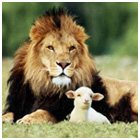3.2 All Creatures Great and Small
Volume 3: Living Symbols—Chapter 2
All Creatures Great and Small
“Then God said, ‘Let the waters abound with an abundance of living creatures, and let birds fly above the earth across the face of the firmament of the heavens.’ So God created great sea creatures and every living thing that moves, with which the waters abounded, according to their kind, and every winged bird according to its kind. And God saw that it was good. And God blessed them, saying, ‘Be fruitful and multiply, and fill the waters in the seas, and let birds multiply on the earth.’ So the evening and the morning were the fifth day….” The creation account presents an orderly progression (if we allow for the obviously symbolic vocabulary) from chaos to order, from darkness to light, and from inert to living. Having created (Hebrew bara—created out of nothing) matter, energy, time, space, and physical laws to govern them all, God then introduced the “foundational” sorts of living things whose job it was to prepare the earth for our habitation—primitive plant life to break down rock into soil, exhale free oxygen to build an atmosphere, and provide a nutritional base for the life forms that would follow.
And follow they did. I rather imagine that here, on the fifth “day” of creation, is when Yahweh really started to enjoy Himself, creating animals, relatively simple and aquatic at first, then increasingly complex, eventually inhabiting the land, and even the sky. And the sixth “day” saw a veritable explosion of life: “Then God said, ‘Let the earth bring forth the living creature according to its kind: cattle and creeping thing and beast of the earth, each according to its kind,’ and it was so. And God made the beast of the earth according to its kind, cattle according to its kind, and everything that creeps on the earth according to its kind. And God saw that it was good….” Reproducing only “according to your kind,” of course, makes evolution from one “kind” of animal into another an impossibility. It’s something scientists universally observe in nature but are philosophically loath to accept. The truth is that Yahweh created an incredible variety of individual kinds of life upon the earth, so many, in fact, that we still haven’t found them all, though we live in awestruck wonder at what we have discovered so far.
Who are awestruck? We are—people, human beings, the last, most advanced, and most unique of all the life forms Yahweh is said to have introduced into our world. “Then God said, ‘Let Us make man in Our image, according to Our likeness.’” I get the feeling that lichens and lemurs, bacteria and baboons, don’t spend much time pondering the wonders of creation, their place in the universe, or even their own existence. Only man does that, because we’ve been “made in God’s image,” whatever that means. So He “‘Let them have dominion over the fish of the sea, over the birds of the air, and over the cattle, over all the earth and over every creeping thing that creeps on the earth.’” Everything but other men, it appears. “So God created man in His own image; in the image of God He created him; male and female He created them. Then God blessed them, and God said to them, ‘Be fruitful and multiply; fill the earth and subdue it; have dominion over the fish of the sea, over the birds of the air, and over every living thing that moves on the earth.’” (Genesis 1:20-28)
As usual, I find myself asking why. God (I suppose) could have made do with a considerably less complicated ecosphere—less interesting, less impressive, less wonderful. Why did He go to all the trouble of making the world so very good? During the fourth day, you’ll recall, He invested the heavenly bodies—the sun, moon, and stars—with symbolic significance, giving them to us for “signs and seasons, and for days and years.” Significant to whom? To us—to people—those creatures who are made in His image and likeness. And it appears that some of Yahweh’s living handiwork was intended to serve precisely the same function: to symbolize various truths and concepts God wanted us to learn and know, concepts that conspire to reveal His nature and His plan. In the previous unit, we looked at God’s symbolic use of things we ingest, taste, and smell—things that nourish us, that flavor our lives. In the next one, we’ll study the metaphorical meaning of the plants and trees that populate our common experience. But for now, let us consider the symbols of the sixth day: animals, the living creatures with whom we share the earth. As before, Yahweh has chosen to invest a select few of them with special symbolic significance, referring to them over and over again in scripture.
(First published 2014)




